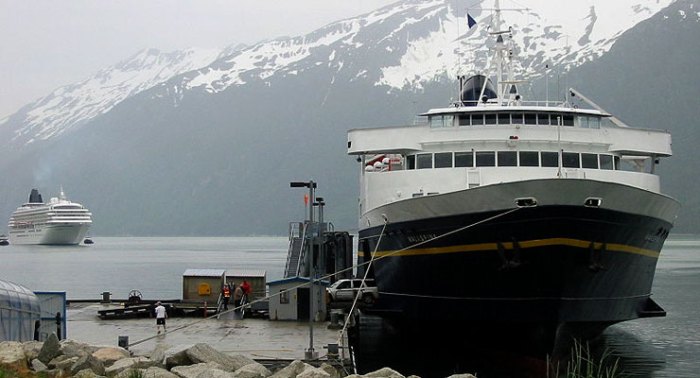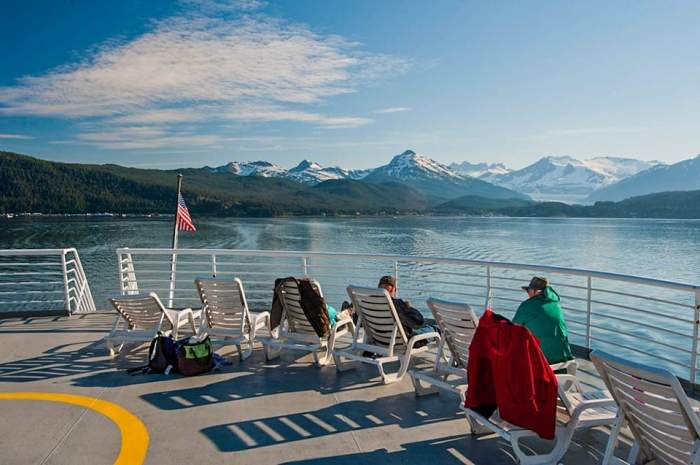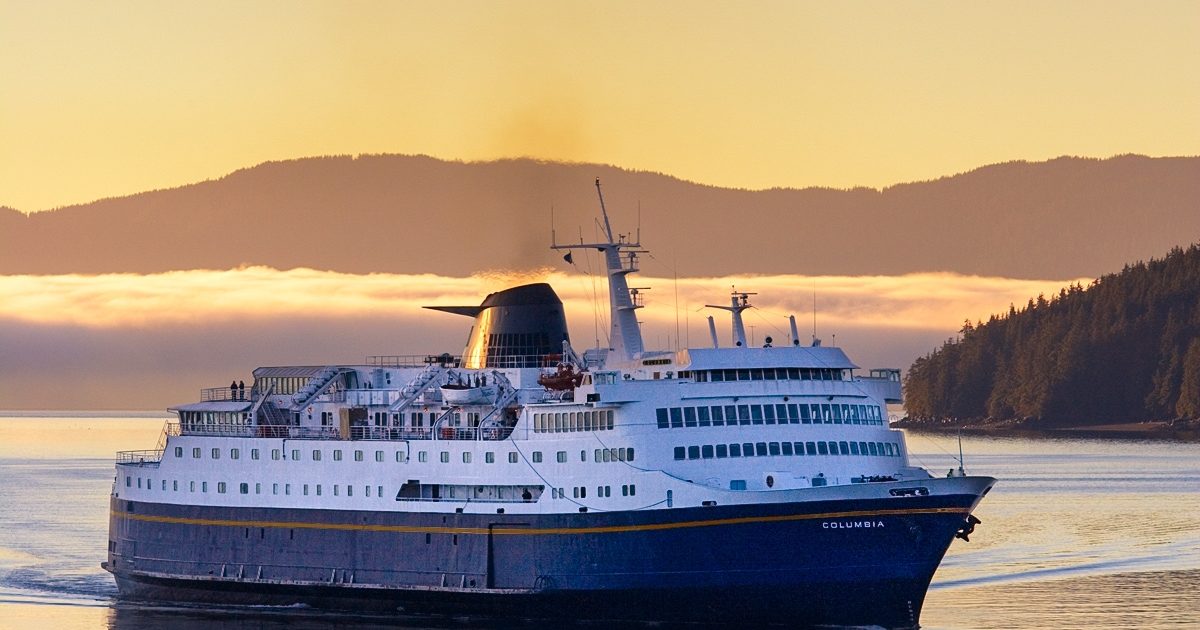Embark on an extraordinary journey through the breathtaking landscapes of Alaska aboard the Alaska Marine Highway. As a vital lifeline for coastal communities and an unparalleled adventure for travelers, this iconic ferry system offers a unique blend of transportation and exploration.
From the majestic fjords of Southeast Alaska to the remote islands of the Aleutians, the Alaska Marine Highway navigates a vast network of waterways, connecting isolated towns and providing access to pristine wilderness areas.
Overview of Alaska Marine Highway

The Alaska Marine Highway System is a ferry system that serves the coastal communities of Alaska. It was established in 1949 to provide transportation and support for the remote communities of the state.
The Alaska Marine Highway System consists of over 3,500 miles of routes and serves 33 communities. The ferries travel through the Inside Passage, the Gulf of Alaska, and the Bering Sea. They provide a vital transportation link for residents and tourists alike, and also support the fishing, tourism, and mining industries.
Routes and Destinations
The Alaska Marine Highway System has five main routes:
- The Inside Passage route runs from Bellingham, Washington, to Skagway, Alaska.
- The Gulf of Alaska route runs from Juneau, Alaska, to Kodiak, Alaska.
- The Bering Sea route runs from Dutch Harbor, Alaska, to Nome, Alaska.
- The Southeast Alaska route runs from Ketchikan, Alaska, to Haines, Alaska.
- The Southwest Alaska route runs from Homer, Alaska, to Unalaska, Alaska.
The ferries on the Alaska Marine Highway System stop at over 30 communities, including major cities like Juneau and Ketchikan, as well as smaller villages like Gustavus and Pelican.
Role in Connecting Communities
The Alaska Marine Highway System is a vital transportation link for the coastal communities of Alaska. It provides a way for residents to travel to and from the mainland, and it also supports the transportation of goods and services.
The ferries also play an important role in tourism. They provide a way for visitors to see the stunning scenery of Alaska, and they also support the local economy by bringing tourists to coastal communities.
Fleet and Infrastructure

The Alaska Marine Highway System operates a fleet of 11 ferries that provide transportation to communities throughout the state. These vessels range in size and capacity, with the largest being able to accommodate over 500 passengers and 100 vehicles. All of the ferries are equipped with modern amenities, including comfortable seating, dining areas, and accessible facilities for passengers with disabilities.
Vessel Types
- Conventional Ferries: These are the most common type of ferry used in the Alaska Marine Highway System. They have a traditional hull design with a large open deck for vehicles and a superstructure for passengers.
- Catamarans: These high-speed ferries have two hulls that provide greater stability and speed than conventional ferries. They are used on routes with high passenger demand.
- Barges: These vessels are used to transport freight and heavy equipment. They do not have passenger accommodations.
Capacity and Amenities
The capacity of the Alaska Marine Highway System ferries ranges from 50 to over 500 passengers. All of the ferries have comfortable seating, dining areas, and accessible facilities for passengers with disabilities. Some of the larger ferries also have amenities such as gift shops, movie theaters, and play areas for children.
Maintenance and Repair Facilities
The Alaska Marine Highway System has two major maintenance and repair facilities, one in Ketchikan and one in Seward. These facilities are responsible for maintaining and repairing the fleet of ferries. They also provide dry-docking services for other vessels.
The Alaska Marine Highway is a must-explore for nature enthusiasts, offering breathtaking coastal views. While Alaska may not be known for its tropical beaches, the Caribbean is a haven for sun-seekers. Discover the best beaches in the Caribbean with crystal-clear waters and pristine sands, a stark contrast to the rugged beauty of the Alaskan coastline.
The Alaska Marine Highway remains a unique experience, connecting coastal communities and offering a glimpse into the untamed wilderness of the Last Frontier.
Operations and Logistics

The Alaska Marine Highway System operates on a year-round schedule, with some routes having seasonal variations. Ferries depart from terminals in Bellingham, Washington, and various ports in Alaska, including Ketchikan, Juneau, Skagway, Haines, and Whittier.
Ticketing for the Alaska Marine Highway is available online, by phone, or in person at the terminals. Passengers can choose from a variety of cabin options, including private rooms, shared rooms, and reclining seats. Vehicle reservations are also available, and passengers are advised to make reservations well in advance, especially during peak season.
Loading and Unloading, Alaska marine highway
Loading and unloading vehicles and cargo on the Alaska Marine Highway ferries is a complex process that requires careful coordination. Vehicles are loaded and unloaded using a combination of ramps, cranes, and forklifts. Cargo is typically loaded and unloaded using forklifts and pallet jacks.
Exploring Alaska’s pristine wilderness via the Alaska Marine Highway offers a unique blend of adventure and relaxation. While the journey itself is an experience in its own right, discerning travelers seeking elevated comfort may consider incorporating some luxury travel tips to enhance their voyage.
From indulging in gourmet dining to pampering oneself with onboard amenities, the Alaska Marine Highway provides opportunities to elevate your journey while immersing yourself in the breathtaking landscapes of the Last Frontier.
The Alaska Marine Highway System has developed a number of safety and security measures to ensure the safety of passengers and crew. These measures include:
- Regular safety drills and training for crew members
- Closed-circuit television cameras and security guards on all ferries
- Metal detectors and baggage screening at all terminals
- A comprehensive emergency response plan
Economic and Social Impact

The Alaska Marine Highway plays a vital role in the economic and social well-being of coastal communities in Alaska. The ferry system provides essential transportation services, connecting remote communities to the rest of the state and facilitating trade and commerce.
Economic Impact
The Alaska Marine Highway has a significant economic impact on coastal communities. The ferry system supports tourism, trade, and commerce by providing access to goods and services that would otherwise be difficult or impossible to obtain. The ferry system also facilitates the transportation of seafood, timber, and other resources to markets outside of Alaska.
Social and Cultural Significance
The Alaska Marine Highway is more than just a transportation system; it is also a vital part of the social and cultural fabric of coastal communities. The ferry system provides a sense of community and connection for residents and visitors alike. The ferry system also plays a role in preserving Alaska’s unique cultural heritage by providing access to remote villages and communities that are otherwise difficult to reach.
Environmental Considerations

The Alaska Marine Highway System operates under strict environmental regulations and practices to minimize its impact on the pristine marine ecosystems and coastal environments of Alaska.
The system’s vessels comply with all applicable federal, state, and local environmental regulations, including the Clean Air Act, the Clean Water Act, and the Endangered Species Act.
Environmental Impact of Ferry Operations
Ferry operations can potentially impact marine ecosystems and coastal environments through:
- Noise and vibration from engines and propellers
- Discharge of wastewater and solid waste
- Disturbance of marine life and habitats
- Introduction of invasive species
Measures to Minimize Environmental Impact
The Alaska Marine Highway System has implemented several measures to minimize its environmental impact, including:
- Using low-noise and low-emission engines and propellers
- Installing advanced wastewater treatment systems
- Implementing waste reduction and recycling programs
- Conducting regular environmental monitoring and assessments
- Working with local communities and environmental organizations to identify and address environmental concerns
Future Developments and Challenges

The Alaska Marine Highway faces an exciting future with potential developments and expansions. However, it also encounters challenges such as climate change and funding constraints. Embracing innovative solutions and technologies will be crucial for the ferry system’s efficiency and sustainability.
The Alaska Marine Highway provides a unique way to explore the breathtaking Alaskan coastline, offering a scenic journey that connects remote communities and allows for whale watching and wildlife sightings. While the Caribbean may not be accessible via the Alaska Marine Highway, it offers a contrasting experience with its crystal-clear waters and pristine best beaches in the Caribbean.
Upon returning to the Alaska Marine Highway, the journey continues through majestic fjords and towering mountains, providing an unforgettable adventure in the heart of the Alaskan wilderness.
Future Developments
- Expansion of Services: Extending ferry routes to underserved communities, increasing frequency on existing routes, and exploring new destinations to enhance connectivity.
- Modernization of Fleet: Investing in newer, more efficient vessels with improved amenities, reduced emissions, and increased capacity to meet growing demand.
- Alternative Fuel Sources: Exploring sustainable fuel options such as electric or hybrid propulsion systems to reduce environmental impact and operational costs.
Challenges
- Climate Change: Rising sea levels, changing weather patterns, and melting sea ice can affect ferry operations, requiring adaptations such as modified routes and enhanced vessel capabilities.
- Funding Constraints: Limited funding can impact the ferry system’s ability to maintain and expand services, necessitating creative financing solutions and efficient resource allocation.
Innovative Solutions and Technologies
- Data Analytics: Utilizing data to optimize scheduling, improve vessel utilization, and enhance passenger experience.
- Autonomous Ferry Technology: Exploring the potential of autonomous ferries to increase efficiency, reduce operating costs, and improve safety.
- Shore-Based Infrastructure Upgrades: Investing in modern terminals, improved loading and unloading facilities, and renewable energy sources to support ferry operations.
Closure: Alaska Marine Highway

As the sun dips below the horizon, casting a golden glow over the tranquil waters, the Alaska Marine Highway concludes its voyage, leaving an unforgettable imprint on the hearts of travelers. Its legacy as a connector of communities, a supporter of tourism, and a guardian of Alaska’s natural beauty will continue to inspire generations to come.
FAQ Explained
What is the Alaska Marine Highway?
The Alaska Marine Highway is a ferry system that provides transportation and access to coastal communities in Alaska.
What is the purpose of the Alaska Marine Highway?
The Alaska Marine Highway serves as a vital transportation link for coastal communities, supporting tourism, trade, and commerce, while also connecting residents to essential services and opportunities.
What are the routes and destinations served by the Alaska Marine Highway?
The Alaska Marine Highway operates on multiple routes, connecting Southeast Alaska, the Gulf of Alaska, and the Aleutian Islands, with stops at various ports and communities.
What types of vessels are used in the Alaska Marine Highway?
The Alaska Marine Highway fleet includes a range of vessels, from smaller ferries to larger ships, designed to accommodate passengers, vehicles, and cargo.